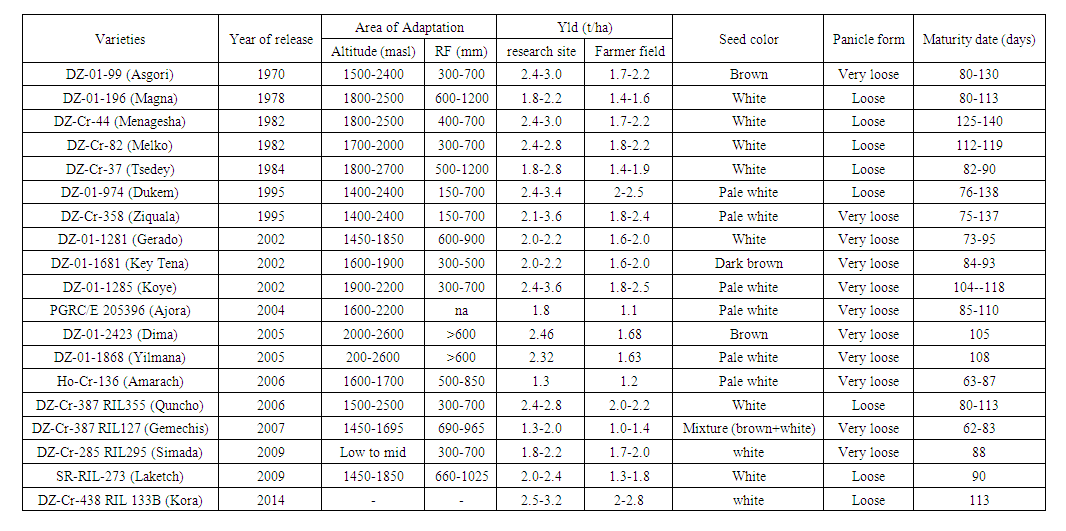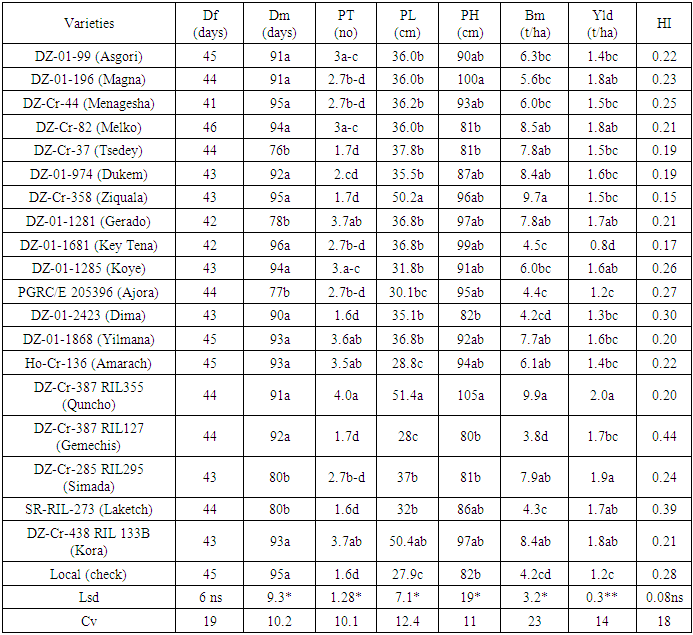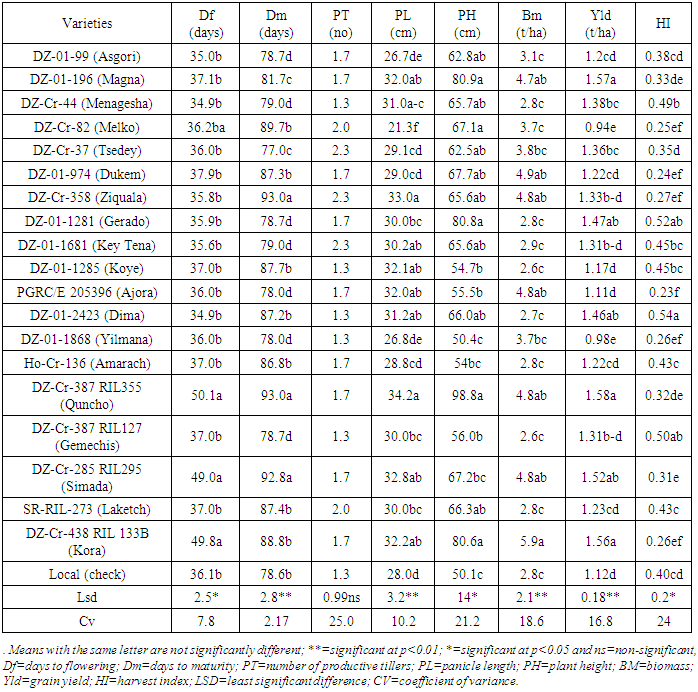Molalign Assefa
Southern Agriculture Research Institute, Worabe Center, Worabe, Ethiopia
Correspondence to: Molalign Assefa, Southern Agriculture Research Institute, Worabe Center, Worabe, Ethiopia.
| Email: |  |
Copyright © 2020 The Author(s). Published by Scientific & Academic Publishing.
This work is licensed under the Creative Commons Attribution International License (CC BY).
http://creativecommons.org/licenses/by/4.0/

Abstract
Tef is one of the most important staple food crops cultivated throughout the country. Twenty (20) Tef varieties (including local check) were brought from Debre Zeit Agricultural Research center and planted in randomized complete block design (RCBD) with three replications at Wulbareg and Dalocha woreda for two consecutive years. The study used Plots size 2mx2m with 1.5m, 1m distances b/n blocks and plots, respectively. The result of analysis revealed significant differences among genotypes in biomass and grain yield. Based on days to maturity, Tsedey (76 days) was found to be the earliest maturing variety with relatively higher grain yield while Ziquala (96 days) was late matured than all other varieties. Quncho and Kora performed best and high yielder in good rainfall spreading season (rain fall distribution within a year suitable land preparation and tef growth) while Tsedey performed better in low rainfall spreading season.
Keywords:
Adaptation, Genotype, Midland, Tef
Cite this paper: Molalign Assefa, Performance Evaluation and Adaptation Trial of Tef (Eragrostis tef (Zucc.) Trotter) Genotypes for Midland Areas of Siltie Zone, Southern Ethiopia, International Journal of Plant Research, Vol. 10 No. 4, 2020, pp. 67-71. doi: 10.5923/j.plant.20201004.01.
1. Introduction
Tef (Eragrostis tef (Zucc.) Trotter) (2n =4x =40) classified under poaceae family and Eragrostis genus. Tef is an annual cereal crop most widely grown over broad environmental conditions. Its center of origin and diversity is in Ethiopia and is widely cultivated throughout the country as a staple food crop [1]. The harvested caryopsis is chiefly used for preparing "injera" (a flat, circular and very soft bread), porridge, and sometimes alcoholic drinks. The bread made of tef flour, "injera", is the mainstay of the Ethiopian diet [2-4]. The nutrient composition of tef grain has high potential to be used in foods and beverages worldwide [5]. Tef annually occupies over 29% of the entire field and contributes approximately 19% of the gross grain output of all cereals in Ethiopia [6]. The production area of tef is increasing in extraordinary scale due to increased market demand, higher nutritional value, low incidence of damage by insects, better adaptation to drought and high value of straw [3].The performance of one genotype differs significantly from environment to environment [7]. Tef performs in different environments differently. Genetically, tef is adaptable to a wide range of environmental conditions and even under unfavorable environmental condition. It can be grown at altitudes ranging from near sea level to 3000 mas, but it performs well between 1100 and 2950 masl [2]. Despite its versatility in adjusting to different environmental conditions, the productivity of tef in Ethiopia is very depressed with the national average standing at 1.6 t/ha [8]. In areas of southern Ethiopia, it is lower than the average grain yield, which may be due to lack of improved varieties, non-adoption of improved technologies, diseases and pests are some of the most serious production constraints. Currently different varieties of tef have been released from the regional and Ethiopian Agricultural Research Institutes [9]. Even though some varieties of tef have been released in Ethiopia, most of them were not evaluated country-wide including in areas of southern regions of Ethiopia. So, the following experiment is objected to evaluate and recommend best performing tef genotypes with better performance and adaptability for the tef growers of Southern Ethiopia in the case Siltie zone agroecological conditions.
2. Materials and Methods
Description of study areaThe experiment was conducted at Siltie Zone in two woreda (Dalocha and Wulbareg) Worabe Agricultural Research Center on station and FTC (Farmer Training center) for two consecutive main cropping seasons from 2017/18 and 20118/19. Siltie zone (Worabe town) is found 173 km south of Addis Ababa. Wulbareg and Dalocha situated at 9°4’N 38°30’ E, and 7°45’N 38°20’ latitude and longitude at an altitude of 2070 masl and 1878 masl, respectively. The soil of study area is characterized by well-drained sandy loam (46% sand, 36% silt and 18% clay), with a pH range of 5.2- 7.6. The most commonly cultivated crops in its surrounding areas are tef, maize and wheat in Wulbareg and Dalocha Woredas.Experimental materials and designNineteen improved tef varieties were brought from Debre Zeit Agricultural research center (Table 1). A total of twenty Tef varieties, including a local check were planted in a RCBD with three replications at Wulbareg woreda (on station) and Dalocha woreda (FTC) from 2017/18 to 2018/19 main cropping seasons. Even if some of the selected genotypes were old varieties but the research center in the area was established in recent time. Therefore, to identify tef genotypes collecting old varieties were needed. Each variety was planted in plot area of 4 m2 on plot size of 2 m height and 4 m width and sown in row method. All agronomic practices were equally performed for all treatments as per recommendations. | Table 1. Lists and descriptions of experimental materials. na=not available |
Collected datav Days to flowering: the number of days from 50% of the plots showing seedling emergence up to 50% of the plants in the plot flower.v Days to maturity: the number of days from 50% of the plots showing seedling emergence up to 50% of the plants in the plot reaching phonological maturity stage (as evidenced by eye-ball judgment of the plant stands when the color is changed from green to color of straw).v Plant height (cm): measured as the distance from the base of the stem of the main tiller to the tip of the panicle at maturity.v Panicle length (cm): the length from the node where the first panicle branch starts up to the tip of the main panicle at maturity.v Number of fertile tillers per plant: the number of panicle-bearing (fertile) tillers produced per plant.v Total biomass (g): the weight of all the harvestable area including tillers harvested at the level of the ground.v Grain yield (g): the weight of grain yield for all the harvestable area of plot.v Harvest Index (HI): It is the value computed as the ratio of grain yield (adjusted to 12.5% moisture) to the total above-ground biomass yield (the sum of both grain and shoot biomass yield) expressed in percent. Data analysisThe collected data were subjected to analysis of variance (ANOVA) as suggested by using SAS Software (Version 9.0) [10]. Mean separation was carried out using least Significant Difference (LSD) at 5 percent level of significance.
3. Results and Discussion
Performance of genotypesAt Wulbareg location the two years combined data Analysis of variance showed a significant difference among tef genotypes at (p<0.05), for days to maturity, biomass and grain yield for all cropping seasons except for days to flowering and harvest index (Table 2).Table 2. Mean performance of 20 tef test genotypes for 8 traits tested at Wulbareg (Average over two cropping seasons)
 |
| |
|
At Dalocha woreda the two years combined data Analysis of variance showed a significant difference among tef genotypes at (p<0.05), for days to maturity, biomass and grain yield for all cropping seasons except for number of productive tillers (Table 3).Table 3. Mean performance of 20 tef test genotypes for 8 traits tested at Dalocha (Average over two cropping seasons)
 |
| |
|
In agreement with the current study, Fentie et al. [11] and Yasin and Agedew [12] also reported considerable variation in the days to maturity, plant height and spike length and grain yield of different tef varieties when planted over years. Days to maturity: At Wulbareg location Significant different was observed among genotypes in all cropping seasons in days to maturity. Tseday (76 days) was matured earlier than all other varieties under study while Ziquala (96 days) and the local check (95 days) was late matured than all other varieties (Table 2). At Dalocha location Tseday (77 days) was matured earlier than all other varieties and Ziquala (93 days) and Quncho (92 days) were late matured than all other varieties (Table 3). In line with the current finding, Yasin and Agedew [12] observed significant different among genotypes in days to maturity.Productive tillers: at Wulbareg location Analysis of variance showed significant difference among varieties in productive tillers. Maximum number of productive tillers was recorded for Quncho (4.00) while minimum number of productive tillers was observed for local check (1.6) (Table 2). Similar result was reported by Aliyi et al. [14].Panicle length: at Wulbareg Significant differences among varieties were observed. The longest panicle length was recorded for Quncho (51 cm) followed by Kora (50 cm) while the lowest panicle length was recorded for local check (29 cm) followed by Lakech (32 cm) (Table 2). In the same way at Dalocha site the longest panicle length recorded for quncho (34 cm) followed by Ziquala (33 cm) while the shortest length was recorded for Melko (21 cm) followed by local check (28cm). in line with Yasin and Agedew [12] and Aliyi et al. [14] reported significant panicle length among different tef varieties.Plant height: at Wulbareg Analysis of variance showed a significant difference among tef varieties under study. The longest variety was Quncho (105.0 cm) followed by Gerado (99 cm) while the shortest varieties were Tsedey, melko and Simada (81 cm) followed by Local check (82 cm) (Table 2). At Dalocha site the longest variety was Quncho (99.0 cm) followed by Gerado, Kora, and Magna (81 cm) while the shortest varieties were Local check and Yilmana (50 cm) (Table 3). Yasin and Agedew [12] and Aliyi et al. [14] reported significant plant height among different tef varieties. In contrast to current finding, Fentie et al. [11] reported non-significant difference among tef varieties over years in plant height.Biomass: at Wulbareg Analysis of variance showed significant difference among varieties under study overall years (Table 2). The highest biomass was recorded for Qunchoand Ziquala (10t/ha) followed by Melko (8.5 t/ha). The lowest biomass was recorded for Gemechis 938 t/ha) Table (2). In similar way at Dalocha site the highest biomass was recorded for Kora (6 t/ha) followed by Magna, Quncho and Dukem (5t/ha) while the lowest was recorded for Gemechis (3t/ha) and Local check (3 t/ha) Table (3). Grain yield: at Wulbareg woreda Significant difference were observed for tef varieties under study. The highest grain yield was recorded for Quncho (2.0 t/ha) followed by Simada and Kora 1.9 t/ha and 1.8 t/ha, respectively. The lowest grain yield was recorded for Key Tena (0.8 t/ha) followed by Local check (1.2 t/ha). At Dalocha highest grain yield was recorded for Quncho (1.58 t/ha) followed by Magna (1.57 t/ha), in contrast the lowest grain yield was recorded by Ajora and Local check 1.1 t/ha (Table 3).The current finding agrees with Fentie et al. [11]; Aliyi et al. [14] and Yasin and Agedew [12] reported significant grain yield among different tef varieties.Harvest index: Significant difference were observed for in harvest index (p<0.05) (Table 3). The harvest index of tef is very low compared to other cereal crops, implying that the total grain yield is very low compared to biomass or straw yield. The highest harvest index was recorded for Dima (54%) while the lowest harvest index was recorded for Key Simada (31%) (Table 3). The result indicates that, there was a positive association between grain yield and total biomass.
4. Conclusions
Analysis of variance showed significant different for all years in biomass and grain yield. From the result different tef varieties interact to the study area differently. Based on days to maturity, Tsedey (76 days) was found to be the earliest maturing variety with relatively higher grain yield while Ziquala (96 days) was later matured than all other varieties. Quncho and Kora performed best and with high yield in a good rainfall season while Tsedey performed better in a low rainfall season, this is an indication of early maturity is best option for tef production in drought prone areas. The result of the study revealed that recommendation of varieties should depending on the anticipated rainfall distribution of study area which is tef genotype performance highly dependent on land preparation and good rain distribution especially during germination (sowing time) and flowering (heading) stages were dependent on moisture availability. In general, based on rainfall forecast of national metrological agency of Ethiopia Tsedey is recommended for low rainfall season (moisture stress) while Quncho, Magna and Kora are recommended for seasons with relatively good rainfall seasons. From the result the author concludes that, for the study areas (midland) lately maturing tef genotypes were highly recommended and advisable for tef production and further tef adaptation trials for the area by incorporating all recently released genotypes were highly recommended.
ACKNOWLEDGEMENTS
The authors acknowledged Southern Agricultural Research Institute for financial support. I also want to thank all crop research teams of Worabe research center.
References
| [1] | Vavilov NI (1951). The origin, variation, immunity and breeding of cultivated plants. LWW 72: 482. |
| [2] | Hailu T, Seyfu K (2000). Production and importance of tef in Ethiopia Agriculture. Hailu T, Getachew B, Mark S (Eds.). Narrowing the Rift: Tef research and development-Proceedings of the international Tef Genetics and improvement, pp: 16-19. |
| [3] | Ketema S (1997). Tef-Eragrostis Tef (Zucc.). Bioversity International. |
| [4] | Kebebew A, Getachew B, Hailu T, Yu JK, Sorrells ME (2009). Breeding tef: conventional and molecular approaches. In New approaches to plant breeding of orphan crops in Africa. Proceedings of an International Conference, Bern, Switzerland, 19-21 September 2007. Organizing Committee of the International Conference on New Approaches to Plant Breeding of Orphan Crops in Africa, pp: 21-41. |
| [5] | Gebremariam MM, Zarnkow M, Becker T (2014). Teff (Eragrostis tef) as a raw material for malting, brewing and manufacturing of gluten-free foods and beverages: a review. Journal of Food Science and Technology 51: 2881-2895. |
| [6] | CSA (Central Statistical Agency) (2018). Crop production forecast sample survey, 2015/16. Report on Area and Crop Production forecast for Major Crops (for private Peasant Holdings ’Meher’ season). Addis Ababa, Ethiopia. |
| [7] | Haldane JB (1946). The interaction of nature and nurture. Annals of Human Genetics 13: 197-205. |
| [8] | CSA (Central Statistical Agency) (2014). Crop production forecast sample survey, 2014/15. Report on Area and Crop Production forecast for Major Crops (for private Peasant Holdings ’Meher’ season). Addis Ababa, Ethiopia. |
| [9] | Kebebew A, Solomon C, Gizaw M (2013). Conventional and Molecular Tef Breeding, In: Kebebew A, Solomon C, Zerihun T (eds.). Achievements and Prospects of Tef Improvement; Proceedings of the Second International Workshop, November 7- 9, 2011, Debre Zeit, Ethiopia, pp: 33-51. |
| [10] | Gomez A, Gomez A (1984). Statistical procedures for agricultural research. 2nd edition, Willey and Son, New York, USA, pp: 97 107. |
| [11] | Fentie M, Demelash N, Jemberu T (2012). Participatory on farm performance evaluation of improved Tef (Eragrostis tef L) varieties in East Belessa, north western Ethiopia. International Research Journal of Plant Science 3: 137-140. |
| [12] | Yasin G, Agedew B (2017). Adaptability Evaluation and Selection of Improved Tef Varieties in Growing Areas of Southern Ethiopia. Hydrol Current Res 8: 2157-7587. |
| [13] | Plaza S, Cannarozzi GM, Tadele Z (2013). Genetic and phenotypic diversity in selected genotypes of tef [Eragrostis tef (Zucc.)] Trotter. African Journal of Agricultural Research 8: 1041-1049. |
| [14] | Aliyi K, Obsa C, Siyoum A, Yeared T (2016). Adaptability Study of Tef Varieties at Mid Land Agro-ecologies of Guji Zone, Southern Oromia. Journal of Natural Sciences Research 6: 124-126. |




 Abstract
Abstract Reference
Reference Full-Text PDF
Full-Text PDF Full-text HTML
Full-text HTML
